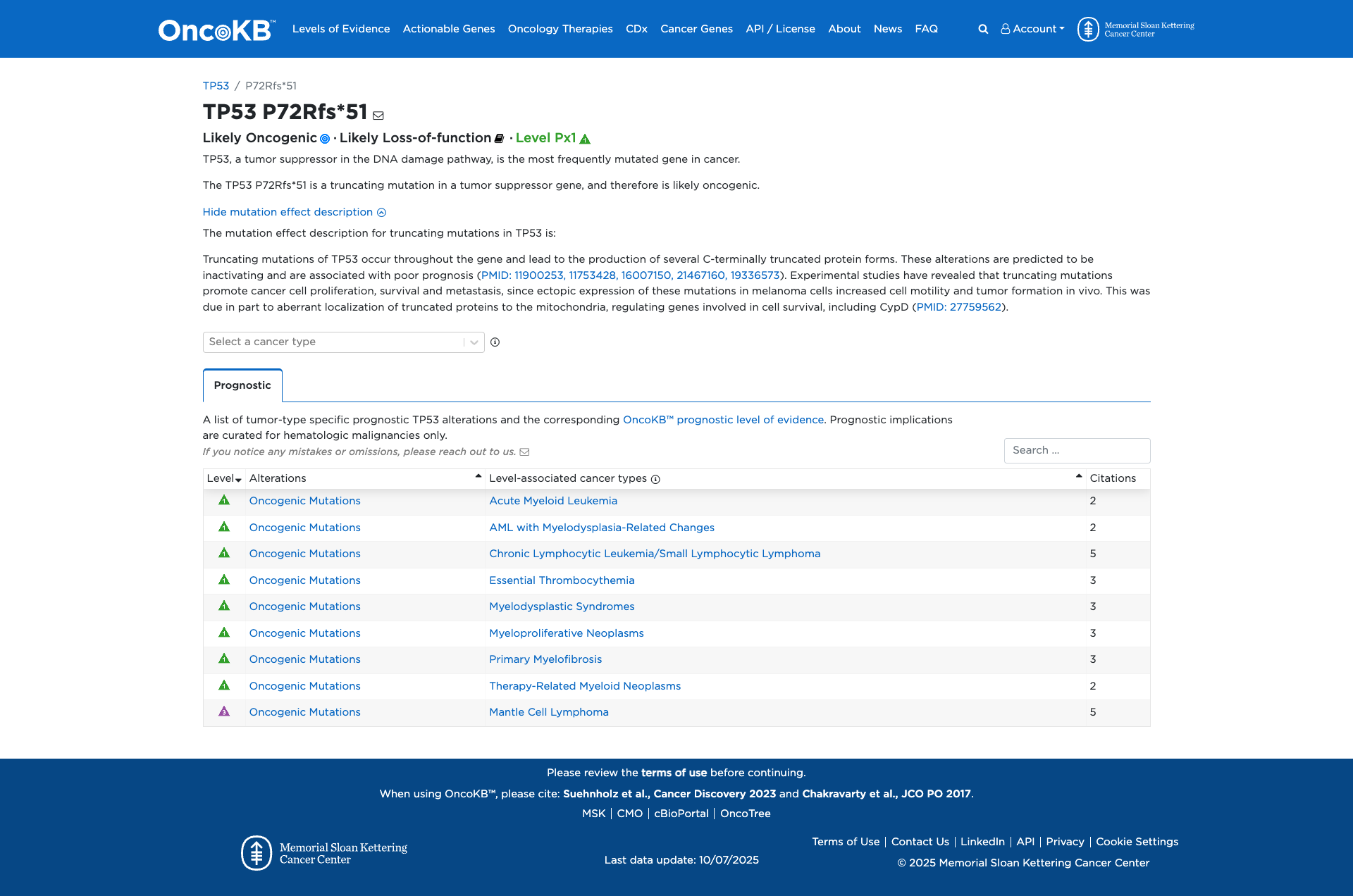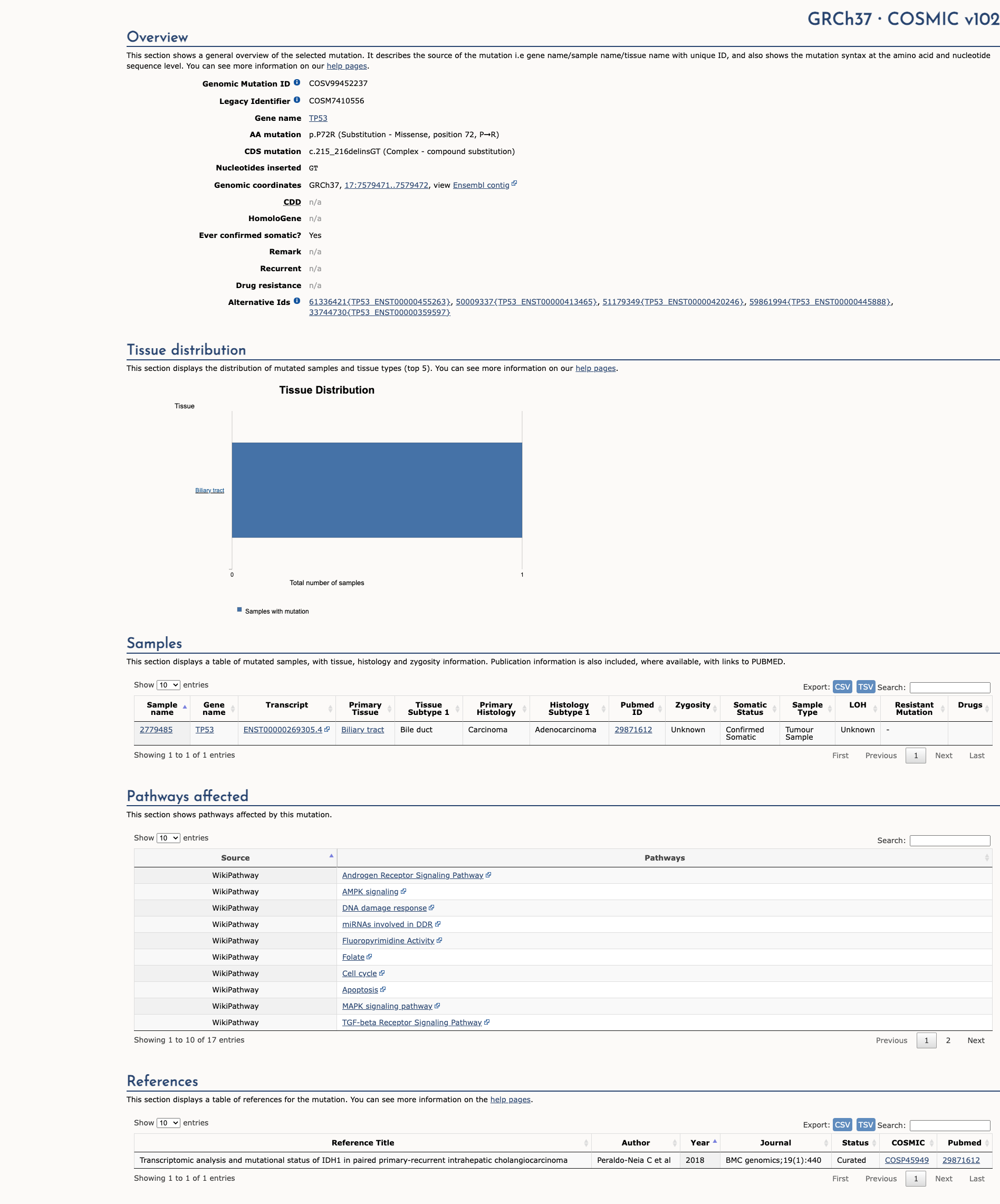TP53 c.215_216delinsG, p.Pro72ArgfsTer51
NM_000546.6:c.215_216delinsG
Pathogenic
The TP53 c.215_216delCCinsG (P72Rfs*51) frameshift variant leads to predicted NMD upstream of p.Lys351 (PVS1_Very Strong) and is absent from population databases (PM2_Supporting). According to VCEP rules, these combine to classify the variant as Likely Pathogenic.
ACMG/AMP Criteria Applied
PVS1
PM2
Genetic Information
Gene & Transcript Details
Gene
TP53
Transcript
NM_000546.6
MANE Select
Total Exons
11
Strand
Reverse (−)
Reference Sequence
NC_000017.10
Alternative Transcripts
| ID | Status | Details |
|---|---|---|
| NM_000546.5 | RefSeq Select | 11 exons | Reverse |
| NM_000546.3 | Alternative | 11 exons | Reverse |
| NM_000546.4 | Alternative | 11 exons | Reverse |
| NM_000546.2 | Alternative | 11 exons | Reverse |
Variant Details
HGVS Notation
NM_000546.6:c.215_216delinsG
Protein Change
P72Rfs*51
Location
Exon 4
(Exon 4 of 11)
5'Exon Structure (11 total)3'
Functional Consequence
Loss of Function
Related Variants
ClinVar reports other pathogenic variants at position 72: P72L
Variant interpretation based on transcript NM_000546.6
Genome Browser
Loading genome browser...
HGVS InputNM_000546:c.215_216delinsG
Active Tracks
ConservationRefSeqClinVargnomAD
Navigation tips: Use mouse to drag and zoom. Click on features for details.
Clinical Data
Population Frequency
Global Frequency
0.0 in 100,000
Extremely Rare
Global: 0.0%
0%
0.05%
0.1%
1%
5%
10%+
ACMG Criteria Applied
PM2
This variant is not present in gnomAD (PM2 criteria applies).
Classification
Unknown
Publications (0)
No publication details.
Clinical Statement
Functional Impact
Functional Domain
Hotspot Status
Not a hotspot
Domain Summary
This variant is not located in a mutational hotspot or critical domain (0 mutations).
Related Variants in This Domain
ClinVar reports other pathogenic variants at position 72: P72L
PM5 criterion applied.
Functional Summary
The TP53 P72Rfs*51 variant is a truncating mutation in the TP53 gene, a critical tumor suppressor involved in the DNA damage response pathway. Functional evidence indicates that truncating mutations in TP53 lead to the production of C-terminally truncated proteins, which are predicted to be inactivating. These alterations have been experimentally shown to promote cancer cell proliferation, survival, and metastasis, partly due to aberrant mitochondrial localization and regulation of survival-related genes. Therefore, the TP53 P72Rfs*51 variant is functionally characterized as likely damaging.
Database Previews
OncoKB

JAX-CKB

Click on previews to view full database entries. External databases may require institutional access.
Computational Analysis
Pathogenicity Predictions
Predictor Consensus
Unknown
PP3 Applied
No
VCEP Guidelines
Applied ACMG/AMP Criteria (VCEP Specific) VCEP Guidelines
PVS1
PVS1 (Very Strong)
According to VCEP guidelines for PVS1: "Nonsense or frameshift variants predicted to result in nonsense-mediated decay (NMD) for nonsense variants upstream of p.Lys351 and for frameshift induced premature termination codon (PTC) upstream of p.Lys351: PVS1 (Very Strong Strength)". The evidence for this variant shows: the c.215_216delCCinsG (P72Rfs*51) creates a frameshift resulting in a premature stop codon upstream of p.Lys351, predicted to trigger NMD. Therefore, this criterion is applied at Very Strong strength because it meets the VCEP conditions for NMD upstream of p.Lys351.
PS1
PS1 (Not Applied) Strength Modified
According to VCEP guidelines for PS1: "Can be applied to variants asserted as Pathogenic or Likely Pathogenic following TP53 VCEP’s specifications" for missense variants. The evidence for this variant shows: c.215_216delCCinsG is a frameshift, not a missense. Therefore, this criterion is not applied.
PS2
PS2 (Not Applied) Strength Modified
According to VCEP guidelines for PS2: point system based on confirmed de novo events. The evidence for this variant shows: no de novo data available. Therefore, this criterion is not applied.
PS3
PS3 (Not Applied) Strength Modified
According to VCEP guidelines caveat: "PS3 should not be applied at any strength if PVS1 is applied at full strength." The evidence for this variant shows: PVS1_Very Strong has been applied. Therefore, PS3 is not applied.
PS4
PS4 (Not Applied) Strength Modified
According to standard ACMG guidelines for PS4: "Increased prevalence in affected individuals over controls" with a point system. The evidence for this variant shows: no case-control or proband point data. Therefore, this criterion is not applied.
PM1
PM1 (Not Applied) Strength Modified
According to VCEP guidelines for PM1: "Missense variants within hotspot codons". The evidence for this variant shows: it is a frameshift variant, not missense. Therefore, this criterion is not applied.
PM2
PM2 (Supporting) Strength Modified
According to VCEP guidelines for PM2: "This rule should be applied at supporting level. Variant should have an allele frequency of less than 0.00003 (0.003%) in gnomAD”. The evidence for this variant shows: absent from gnomAD (MAF=0%). Therefore, this criterion is applied at Supporting strength because the variant’s frequency is below the threshold.
PM3
PM3 (Not Applied) Strength Modified
According to standard ACMG guidelines for PM3: "For variants in trans with a pathogenic variant in recessive disorders". The evidence for this variant shows: not evaluated in a recessive context. Therefore, this criterion is not applied.
PM4
PM4 (Not Applied) Strength Modified
According to standard ACMG guidelines for PM4: "Protein length changes due to in-frame indels or stop-loss variants". The evidence for this variant shows: it is a frameshift predicted to cause NMD, covered by PVS1. Therefore, this criterion is not applied.
PM5
PM5 (Not Applied) Strength Modified
According to VCEP guidelines for PM5: "Missense variant at an amino acid residue where pathogenic missense changes were seen". The evidence for this variant shows: it is a frameshift, not missense. Therefore, this criterion is not applied.
PM6
PM6 (Not Applied) Strength Modified
According to standard ACMG guidelines for PM6: "Assumed de novo without confirmation of paternity/maternity". The evidence for this variant shows: no de novo information. Therefore, this criterion is not applied.
PP1
PP1 (Not Applied) Strength Modified
According to VCEP guidelines for PP1: "Cosegregation in families". The evidence for this variant shows: no segregation data available. Therefore, this criterion is not applied.
PP2
PP2 (Not Applied) Strength Modified
According to standard ACMG guidelines for PP2: "Missense variant in a gene with low rate of benign missense variants". The evidence for this variant shows: it is a frameshift. Therefore, this criterion is not applied.
PP3
PP3 (Not Applied) Strength Modified
According to VCEP guidelines caveat: "PP3 should not be used in combination with PVS1." The evidence for this variant shows: PVS1 applied. Therefore, this criterion is not applied.
PP4
PP4 (Not Applied) Strength Modified
According to standard ACMG guidelines for PP4: "Phenotype specificity". The evidence for this variant shows: no phenotype specificity data. Therefore, this criterion is not applied.
PP5
PP5 (Not Applied) Strength Modified
According to standard ACMG guidelines for PP5: "Reputable source reports variant as pathogenic". The evidence for this variant shows: no such reports. Therefore, this criterion is not applied.
BA1
BA1 (Not Applied) Strength Modified
According to VCEP guidelines for BA1: "Stand-alone benign filtering allele frequency ≥0.001". The evidence for this variant shows: absent in population. Therefore, this criterion is not applied.
BS1
BS1 (Not Applied) Strength Modified
According to VCEP guidelines for BS1: "Filtering allele frequency ≥0.0003 but <0.001". The evidence for this variant shows: absent in population. Therefore, this criterion is not applied.
BS2
BS2 (Not Applied) Strength Modified
According to VCEP guidelines for BS2: "Observation in ≥8 unaffected older females". The evidence for this variant shows: no such data. Therefore, this criterion is not applied.
BS3
BS3 (Not Applied) Strength Modified
According to VCEP guidelines for BS3: "Functional data shows no loss of function". The evidence for this variant shows: truncating predicted LOF and PVS1 applied. Therefore, this criterion is not applied.
BS4
BS4 (Not Applied) Strength Modified
According to VCEP guidelines for BS4: "Lack of segregation in affected members". The evidence for this variant shows: no segregation data. Therefore, this criterion is not applied.
BP1
BP1 (Not Applied) Strength Modified
According to standard ACMG guidelines for BP1: "Missense variant in gene where only LOF causes disease". The evidence for this variant shows: it is a LOF variant. Therefore, this criterion is not applied.
BP2
BP2 (Not Applied) Strength Modified
According to standard ACMG guidelines for BP2: "Observed in trans with a pathogenic variant for a dominant disorder". The evidence for this variant shows: not applicable. Therefore, this criterion is not applied.
BP3
BP3 (Not Applied) Strength Modified
According to standard ACMG guidelines for BP3: "In-frame indels in repetitive region without functional impact". The evidence for this variant shows: frameshift variant. Therefore, this criterion is not applied.
BP4
BP4 (Not Applied) Strength Modified
According to VCEP guidelines for BP4: "Computational evidence supports benign effect". The evidence for this variant shows: truncating variant, PVS1 applied. Therefore, this criterion is not applied.
BP5
BP5 (Not Applied) Strength Modified
According to standard ACMG guidelines for BP5: "Variant found in case with an alternate cause". The evidence for this variant shows: no data. Therefore, this criterion is not applied.
BP6
BP6 (Not Applied) Strength Modified
According to standard ACMG guidelines for BP6: "Reputable source reports variant as benign". The evidence for this variant shows: no such reports. Therefore, this criterion is not applied.
BP7
BP7 (Not Applied) Strength Modified
According to VCEP guidelines for BP7: "Synonymous or intronic variant with no splicing impact". The evidence for this variant shows: not applicable (frameshift). Therefore, this criterion is not applied.

